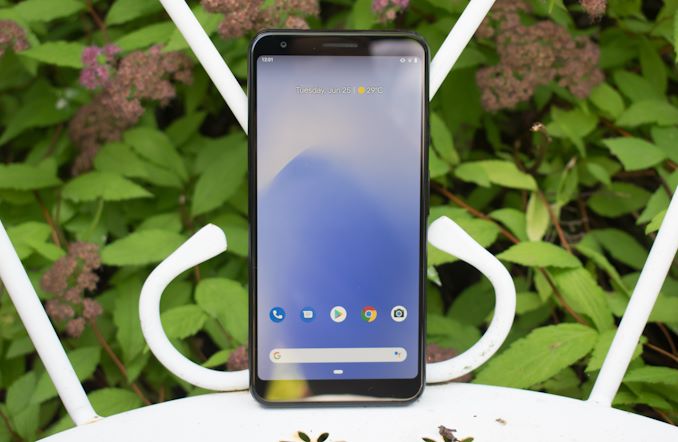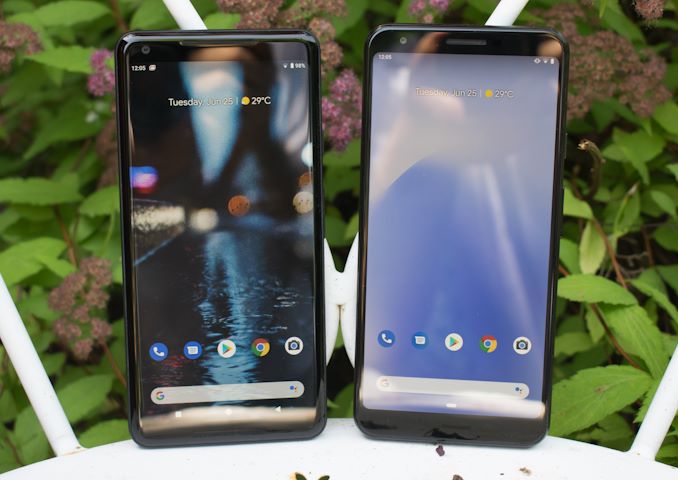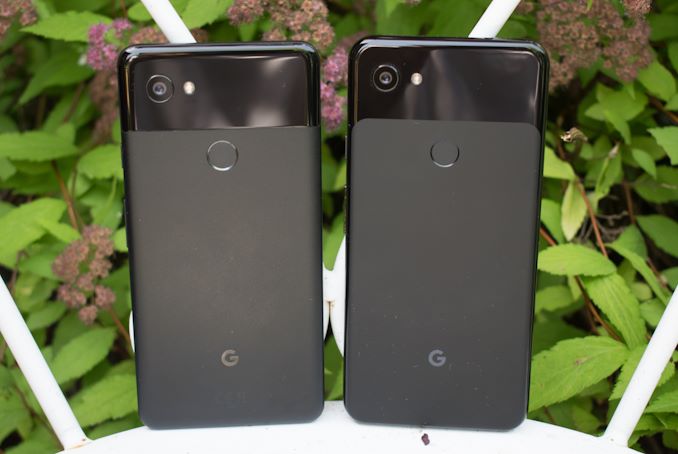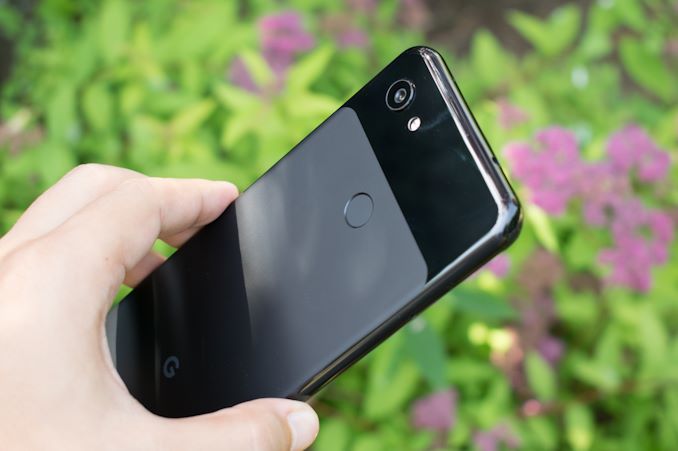The Google Pixel 3a XL Review: Does Mid-Range Make Sense?
by Andrei Frumusanu on June 27, 2019 8:00 AM EST- Posted in
- Mobile
- Smartphones
- Snapdragon 670
- Pixel 3a
- Pixel 3a XL

It’s nearing 8 months since Google released the Pixel 3 and we extensively reviewed the phone. It also has been several years now since Google abandoned the Nexus line of devices; one of the most attractive aspects during the early days of Google’s own phones was their incredible value proposition and very competitive pricing. As Google evolved the Pixel line of smartphones, it was clear that we’d no longer see quite as attractive price-tags, with the Pixel 3 and Pixel 3 XL nearing the $1000/€ mark.
Google apparently did see the higher price points as a hurdle for some consumers, and decided to expand its product line-up by introducing new mid-range devices at much more reasonable price-points, all while maintaining the key features that make the Pixel phones worth their namesake.
The new Pixel 3a and Pixel 3a XL, the latter which we’re reviewing today, are very much derived from the same DNA that was established in the Pixel 2 and further iterated upon in the Pixel 3 range. The Pixel 3a’s still come with the similar industrial design, feature an OLED display, and most importantly feature the very same full-fledged camera as their flagship siblings, at essentially half the cost. Of course, the lower price point comes with changes – a plastic body and a lower tiered SoC are among some of the compromises that have been made, along with a few other features that hit the chopping block.
| Google Pixel 3a's | ||||
| Pixel 3a |
Pixel 3a XL (Reviewed) |
|||
| SoC | Snapdragon 670 2x Kryo 360 (CA75) @ 2.0GHz 6x Kryo 360 (CA55) @ 1.7GHz Adreno 615 |
|||
| DRAM | 4GB LPDDR4X | |||
| Display | 5.6" OLED 2220 x 1080 (18:9) |
6.0" OLED 2220 x 1080 (18:9) |
||
| Size | Height | 151.3 mm | 160.1 mm | |
| Width | 70.1 mm | 76.1 mm | ||
| Depth | 8.2 mm | 8.2 mm | ||
| Weight | 147 grams | 167 grams | ||
| Battery Capacity | 3000mAh (Rated) | 3700mAh (Rated) | ||
| Wireless Charging | - | |||
| Rear Cameras | ||||
| Main | 12.2MP 1.4µm Dual Pixel PDAF f/1.8 76° lens with OIS |
|||
| Telephoto | - | |||
| Wide | - | |||
| Extra | - | |||
| Front Camera | 8MP 1.12µm f/2.2 84° lens; fixed focus |
|||
| Storage | 64GB eMMC | |||
| I/O | USB-C 3.5mm headphone jack |
|||
| Wireless (local) | 802.11ac Wave 2 Wi-Fi Bluetooth 5.0 LE + NFC |
|||
| Cellular | UE Category 11 (DL) / Category 5 (UL) 600Mbit/s DL (3xCA 2x2 MIMO) 75Mbit/s UL |
|||
| Other Features | Dual Speakers, 18W Fast Charging | |||
| Dual-SIM | 1x nanoSIM | |||
| Launch Price | $399 / £399 / €399 | $479 / £469 / €479 | ||
Starting off with the internal hardware of the Pixel 3a’s, we see the devices powered by a Qualcomm Snapdragon 670 SoC. Qualcomm had launched the SoC in August of 2018, so it’s not quite the newest unit on the market, but given the price sensitivity of the product category, that’s to be expected.
The Snapdragon 670 on paper looks very similar to the slightly higher-end Snapdragon 710: The SoC features 2x Cortex A75 derived cores at 2.0GHz and are paired with 6x Cortex A55 derived cores at 1.7GHz. In terms of computational power, it’s clear that we should be expecting the CPUs to perform quite a lot less than the Snapdragon 855 as well as last year’s Snapdragon 845. In terms of single-threaded performance at least, however theoretically the S670 would be able to compete with the S835, which was Qualcomm’s flagship for 2017. In fact, we’ll see some large performance similarities between the Pixel 3a and the Pixel 2, which is going to play a big part in terms of properly evaluating the end value of the Pixel 3a.
The GPU is an Adreno 615. Unfortunately we don’t tend to review mid-range SoC phones as much as we’d like to, so at first glance without testing there’s not too much context on exactly where this GPU lands in terms of performance. While I don’t want to spoil too much, don’t expect too much performance from the smaller IP block, although we’ll see some surprising power characteristics.
The phone comes with 4GB of LPDDR4X sourced by Micron – which is standard for the course and in my opinion still sufficient for today’s workloads – although it’s now on the lower threshold of what phones should be equipped with.
Arguably the phone’s biggest component compromise comes in the form of eMMC storage of which the devices only come with 64GB of, also made by Micron. While the typical NAND speed benchmarks aren’t too terrible, the different storage standard does struggle under heavy parallel workloads.
The display on the Pixel 3a XL is an OLED panel with a diameter of 6.0” with a resolution of 2220 x 1080 and a resulting aspect ratio of 18:9. The phone’s width is very similar to the Pixel 2 XL and Pixel 3 XL, so it’s still very much a big phone.
While the back of the phone very much looks nearly identical to the Pixel 2 XL or Pixel 3 XL, there’s one very major difference: Instead of being a metal or glass back body, the Pixel 3a’s come with a full plastic unibody shell.
The design decision very likely saves a lot on the production cost of the phone, and in my opinion Google’s material choice on the 3a’s has been excellent. The polycarbonate used is of very high quality and definitely one of the best plastic phones I’ve encountered. The phone still features the characteristic glossy top part of the phone, while the bottom is a sanded off matte finish that is surprisingly close to the finish of the glass back on the regular Pixel 3’s, which is great.
The one biggest issue I feel is that the plastic design will be significantly more prone to scratches and dents, and I especially don’t expect the top glossy part of the phone to remain unblemished after a few months of use.
A big selling point for the Pixel 3a is that it sports the very same camera module as the flagship Pixel 3 units. We find the Sony IMX363 sensor which is a 12.2MP unit consisting of 1.4µm pixels with full-sensor dual-pixel PDAF ability. The module houses the same OIS and f/1.8 aperture lens.
On the front camera, Google has dropped the wide-angle module from the Pixel 3 and the 3a only houses the regular front-facing camera, which is an 8MP 1.12µm pixel f/2.2 lens with fixed focus.
It’s to be noted that while Google has dropped the 3.5mm headphone jack from the Pixel 2 and 3, it does make a comeback for the Pixel 3a. Google explains that this is meant to make the device accessible to more users. It’s a bit sad that nowadays you have to buy a lower-tier smartphone to regain a lost feature.
Among other dropped features on the Pixel 3a is the lack of wireless charging. The 3700mAh unit on the XL and 3000mAh should fare fairly fine, and it is an acceptable compromise given the device’s price ranges of $399 for the 3a and $479 for the 3a XL.














94 Comments
View All Comments
UtilityMax - Thursday, August 1, 2019 - link
The low Best Buy prices are for those who are activating a new carrier line. Without activation, the S8 is 500USD, and S9 is 600.I'll take a 400 Pixel 3A easy. Besides price, no round edges is a great win.
Alistair - Thursday, June 27, 2019 - link
My nephew trashed the babysitter's phone and needed to buy a new one recently. I really wanted to buy a Pixel 3A, but it is absolutely trashed by the value of the A50 from Samsung imo. $375 vs $550 in Canada.Stormbolter - Thursday, June 27, 2019 - link
I would like to point that for the rest of the world, Google offers a clean Android Experience that Xiaomi, Huawei or Honor don't offer on the same price range - although Xiaomi, Nokia and Motorola do offer Android One devices, these are lower end, with worse camera and screen.And that the price difference fails to include VAT. Pixel 3a retails for 399/479€ in Spain. The Mi9 retails for ~449€ in the amazon marketplace, but stores (and phone providers) sell it for about 499€. Of course, if you're willing to forego warranty and such, you can import the phone for less, but then... so can someone living in USA (as long as they stick to GSM providers).
Finally, Chinese flagships have all but done away with the phone jack, and middle class offerings tend to be lacking the good camera and screen flagships have.
So, Pixel 3a /3a XL is a good option if you want a clean Android Experience, with a decent camera and screen, at a reasonable price.
Andrei Frumusanu - Thursday, June 27, 2019 - link
The Mi9 is 393€, VAT included, directly from Xiaomi on Amazon.deeastcoast_pete - Thursday, June 27, 2019 - link
Xiaomi phones like the Mi9 can also be had in the US (Amazon and other online retailers). A possible alternative if one sticks to the GSM-based carriers (AT&T, T-MOBILE). However, make sure at least some of the LTE channels are covered by the modem.RSAUser - Thursday, June 27, 2019 - link
The Nokia devices are definitely not lower end.The Nokia 8.1 has a better SoC, which is clocked higher plus HDR support for camera, with a slightly worse battery but the SoC is more power efficient and also has a Google Camera port. It delivers all of that at about 350 EUR inc. of taxes, but sadly not available in the U.S. for you folk.
voicequal - Thursday, June 27, 2019 - link
The headphone jack brought me to the Pixel 3a. It's been great so far. Now if dedicated home and back buttons would make a comeback, UI productivity would be back up to where it was on my first Android phone.imaheadcase - Thursday, June 27, 2019 - link
No idea why "reviews" post how a phone looks or is "prone to scratches". Everyone uses a case anyway with a phone. You see many car reviews about them worry about scratches on them? Nope, its about the insides and engines.Just stop with the headphone jack nonsense, its not a big deal at all. Every test shows people can't tell a different sound wise vs wired with a phone. I've yet to find anyone in real world who cares. Hell most people prefer bluetooth over wired anyway for workout, running, work, etc.
Ratman6161 - Thursday, June 27, 2019 - link
Have to agree on the looks of a phone. My beautiful blue S9+ had a black plastic case on it before I even left the store. Its too darned expensive to take a chance on using it case-less.On the headphone jack...thats another matter. I have a set of blue tooth headphones (used with a TV set, not my S9). Sound quality is fine for my purpose. The problem is that they have a battery. So yet another thing that needs to be kept charged. Workout + running? Why would I want to run with a big honking phone strapped to my arm? For that I need something simple and cheap which is why I'm using my trusty old SanDisk MP3 player.
Inteli - Thursday, June 27, 2019 - link
I'm so glad you're here to tell all us plebians what we need and what we don't need. Of course nobody needs wired headphones! We also don't need anything above 128kbps MP3s. You're lying if you say you can hear a difference. You also don't need a car. Everybody in the city gets by fine without them! Your opinion is obviously the only one that matters and every reviewer should cater to exclusively what you think is important.